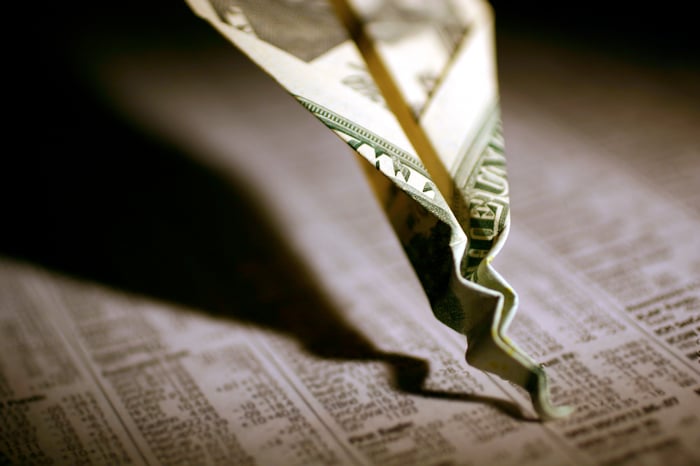Over long periods, the stock market is an unquestioned moneymaker. When compared to other asset classes, such as bonds, oil, gold, and housing, the stock market has delivered a considerably higher annualized rate of return over the long term.
However, the performance of the ageless Dow Jones Industrial Average (^DJI 0.40%), broad-based S&P 500 (^GSPC 1.02%), and innovation-fueled Nasdaq Composite (^IXIC 2.02%) becomes far less certain when examined over the course of a few months to a couple of years. For instance, all three major stock indexes have oscillated between bull and bear markets in successive years since this decade began.

Image source: Getty Images.
When volatility picks up, it's not uncommon for investors to seek out data points or predictive tools that might offer a clue as to where stocks will head next. Although there is no such thing as a metric that's foolproof when it comes to predicting short-term directional moves in the Dow Jones, S&P 500, and Nasdaq Composite, there are a handful of forecasting tools and data points that have strongly correlated with moves higher and lower in the major indexes throughout history.
One such widely followed metric, with a phenomenal track record dating back more than a century, is currently flirting with danger. The question is: Does this highly tracked data point signal the potential for an imminent stock market crash in 2024?
Historically, this is a harbinger of bad news for Wall Street
The valuation tool investors are probably most familiar with is the price-to-earnings (P/E) ratio. The P/E ratio is an easy-to-use measurement that divides a publicly traded company's share price into its trailing-12-month earnings per share.
However, the P/E ratio can be susceptible to wild swings due to unforeseen events, such as the COVID-19 pandemic. That's why a lot of savvy investors also keep track of the S&P 500's Shiller P/E ratio. Note: The Shiller P/E is also commonly referred to as the cyclically adjusted price-to-earnings ratio (CAPE ratio).
The Shiller P/E is based on average inflation-adjusted earnings from the previous 10 years. Looking at inflation-adjusted earnings over a full decade smooths out the fluctuations in corporate operating performance that can observed in one or two outlier years.
S&P 500 Shiller CAPE Ratio data by YCharts.
When back-tested to 1870, the S&P 500's Shiller P/E has averaged a multiple of 17.07. But as you can see in the chart above, it's spent almost the entirety of its time above this level over the past 30 years. The advent of the internet, which democratized access to information and the ability for everyday investors to put their money to work on Wall Street, coupled with historically low interest rates, has fueled multiple expansions and the willingness of investors to take risks.
But there's always a limit to risk-taking.
Over the past 154 years, there have only been six instances where the S&P 500's Shiller P/E surpassed 30 during a bull market rally. The previous five instances were harbingers of bad news for Wall Street:
- 1929: The back-tested Shiller P/E was north of 30 prior to the Black Monday crash of October 1929. The Dow Jones ultimately lost 89% of its value following this top.
- 1997-2001: The Shiller P/E peaked at its all-time high of 44.19 in Dec. 1999, leading up to the dot-com bubble. The S&P 500 went on to lose 49% of its value, with the Nasdaq getting hit even harder.
- Q1 2018-Q3 2018: The Shiller P/E surpassed 30, once more, in 2018. A rough fourth quarter for Wall Street in 2018 saw the S&P 500 decline by 20%.
- Q4 2019-Q1 2020: The fourth instance of the Shiller P/E topping 30 came to a close when the COVID-19 crash hit in February-March 2020. The S&P 500 shed 33% of its value in less than five weeks.
- Q3 2020-Q2 2022: The Shiller P/E crossed 40 during the first week of January in 2022. Following this peak, the Dow, S&P 500, and Nasdaq Composite all entered a bear market, with the S&P 500 losing as much as 25% of its value.
- Q1 2023-current: The S&P 500 Shiller P/E sat above 32 at the closing bell on Dec. 20.
All five previous instances with a Shiller P/E ratio north of 30 have eventually (keyword!) resulted in the S&P 500 losing at least 20% of its value, which is traditionally the line-in-the-sand definition for a bear market.
Keep in mind that this doesn't mean a stock market crash is imminent in 2024. As you'll note by looking at the 1997 to 2001 period, valuations can stay extended for an indeterminate amount of time. Eventually, though, valuation does matter, which has led to significant bear markets for the Dow, S&P 500, and Nasdaq Composite.
If history were to rhyme once more, 2024 has the potential to be a challenging year for investors.

Image source: Getty Images.
Perspective changes everything
But the funny thing about Wall Street is that investor perspective changes everything. For a short-term trader, the Shiller P/E is one of a number of metrics that are currently warning of potential trouble to come for stocks. Yet for long-term-minded investors, downturns tend to be blessings in disguise.
Since the start of 1950, there have been 39 separate double-digit percentage declines in the S&P 500. This works out to a correction, on average, every 1.9 years. But with the exception of the 2022 bear market, every previous correction, crash, and bear market was eventually cleared away by a bull market rally.
Though we're never going to know in advance when corrections will begin, how long they'll last, or how steep the drop will be, history has conclusively shown that the major indexes eventually recoup their losses and push to new all-time highs. This effectively makes every notable drop in the Dow, S&P 500, and Nasdaq Composite a buying opportunity for patient investors.
Researchers at Bespoke Investment Group took this analysis one step further when they examined the average length of bull and bear markets for the S&P 500 dating back to the start of the Great Depression in September 1929. Over this 94-year period, Bespoke identified 27 separate bull and bear markets for Wall Street's widely followed index.
It's official. A new bull market is confirmed.
-- Bespoke (@bespokeinvest) June 8, 2023
The S&P 500 is now up 20% from its 10/12/22 closing low. The prior bear market saw the index fall 25.4% over 282 days.
Read more at https://t.co/H4p1RcpfIn. pic.twitter.com/tnRz1wdonp
The average S&P 500 bear market has lasted 286 calendar days (about 9.5 months), with no downturn exceeding 630 calendar days (Jan. 11, 1973 – Oct. 3, 1974). By comparison, the average S&P 500 bull market has endured 1,011 calendar days (roughly two years and nine months), with 13 of 27 bull markets sticking around longer than the lengthiest bear market. In other words, being optimistic undeniably pays on Wall Street.
An even more comprehensive study from Crestmont Research, which looked at 123 years' worth of total returns data for the S&P 500, further demonstrates the power of time and perspective on Wall Street.
The researchers at Crestmont analyzed the 20-year rolling total returns, including dividends, of the S&P 500, dating back to 1900. Though the S&P didn't exist until 1923, its components could be found in other major indexes prior to this point. This made it relatively easy for analysts to back-test to 1900 and emerge with 104 rolling 20-year periods of total returns data for the S&P 500 (1919-2022).
The stunning takeaway is that all 104 periods produced a positive total return. Regardless of when an investor would have, hypothetically, put their money to work, they would have grown their wealth if they held that position in the S&P 500 for 20 years. The point is that no matter what happens in 2024, the needle is seemingly always pointing higher for optimistic investors willing to use time to their advantage.





